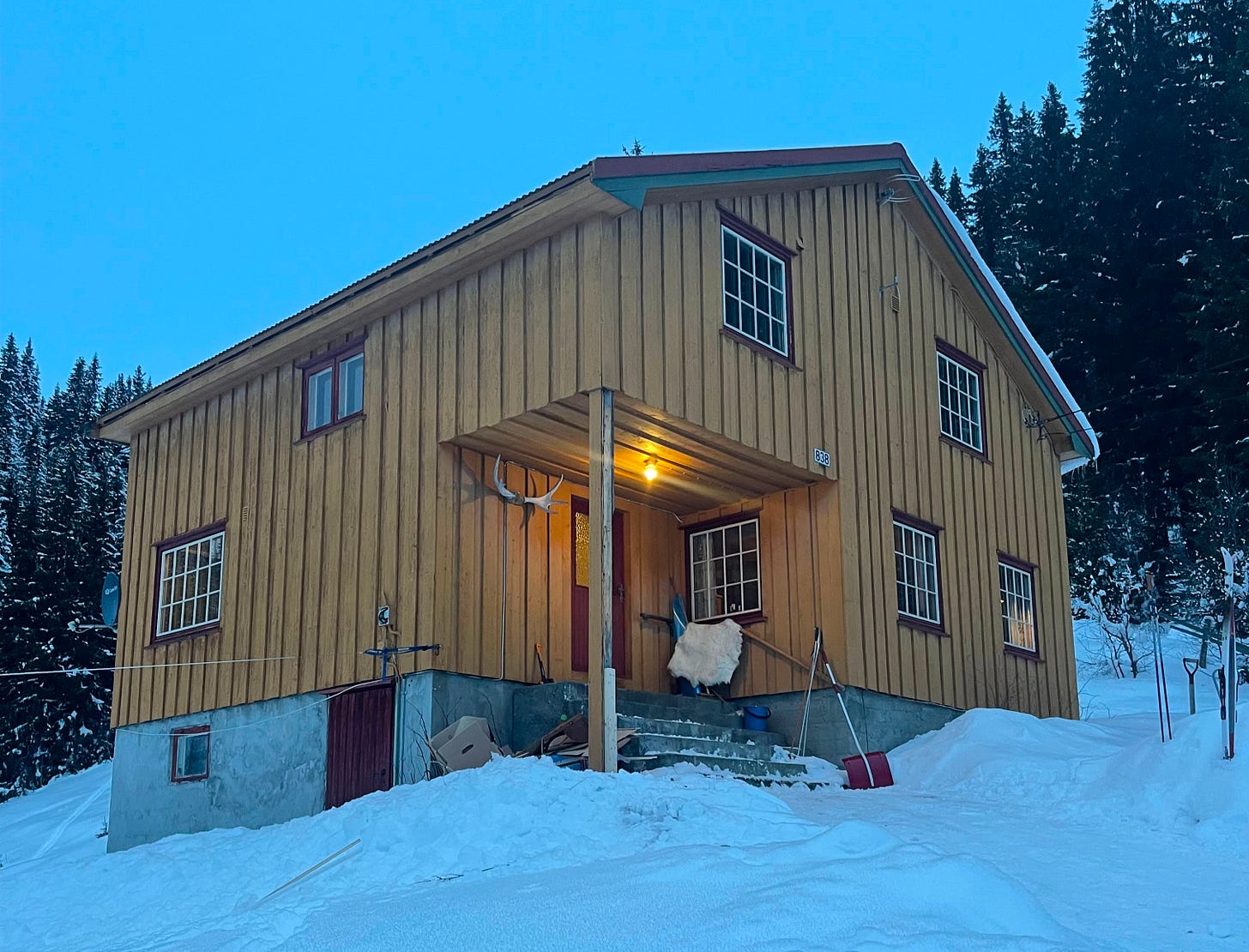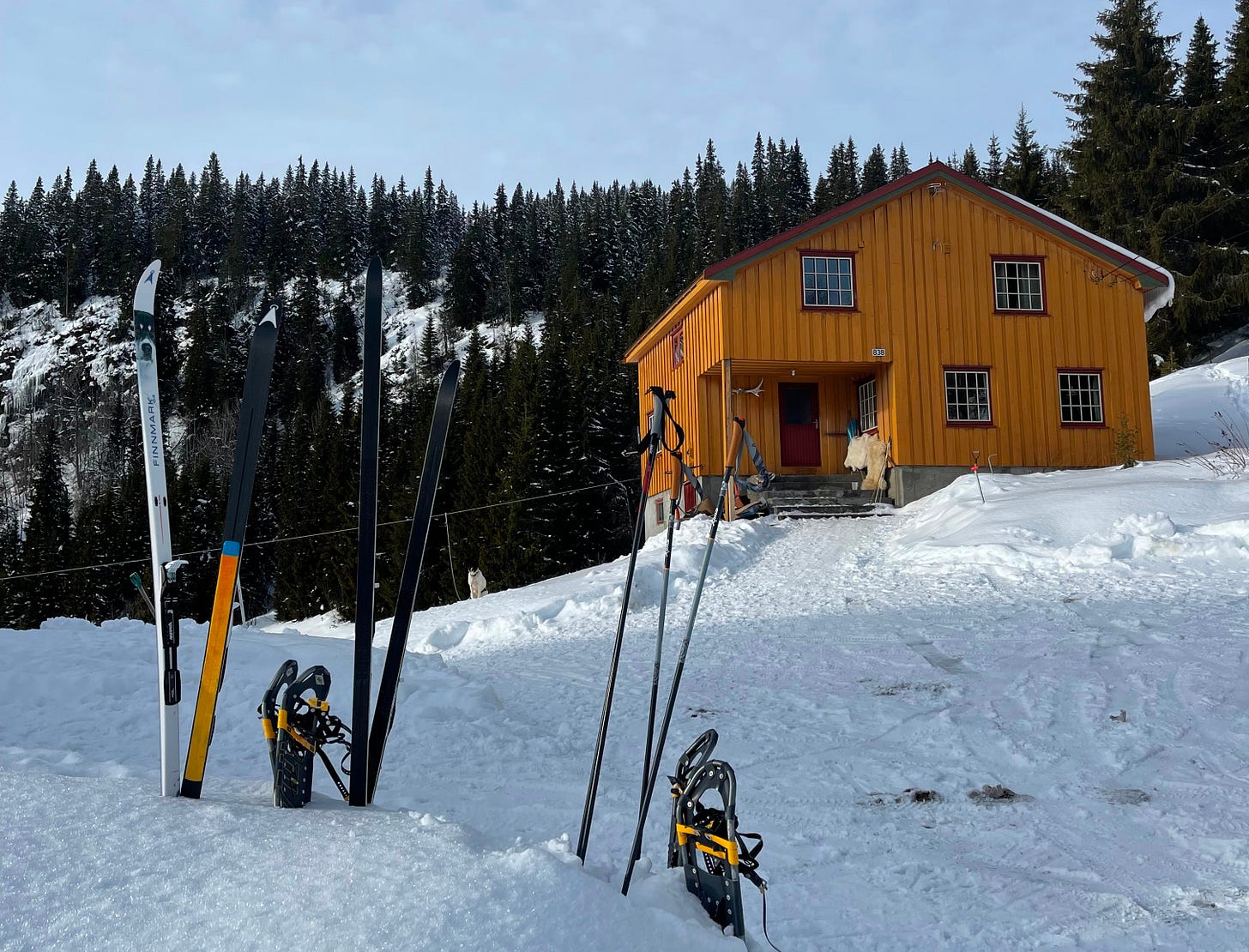Slow living is learned but not taught
Cycle Day 1 forces rest. Norway approves.
I had pictured myself mostly outdoors, hiking for miles in snowshoes or trekking on Nordic skis, maybe taking a tent and turning it into a multi-day event. Camping somewhere under the stars, making a fire and a simple meal. It builds character to spend a night outside when it’s minus fifteen. Cheeks frozen, half awake and hyper-aware, but very alive. Instead, I sit in a wooden house, in a wooden living room, by the wood burner, and I find it difficult. At first.
However, on Cycle Day 1, I feel like a metal band has been fitted around my forehead and temples, the pressure increasing slowly like a medieval torture device. I wake up with this headache and an extremely dry mouth after sleep interrupted by nocturnal tampon-changing activities. It’s like the insides hiding in my pelvis have been taken out and put back wrong. My uterus, bladder, and bowels are inside out, upside down, and simultaneously congealed together.
Having had a strong morning cup of coffee, my bowel is moving, but there is no sensation of urgency. The whole area in my lower abdomen is numb, save for a dull ache in and around my uterus. It feels full there, bruised and hardened. My reproductive organs have turned against their direct environment and host (me!) and seem to have encapsulated in a rubbery tissue of sore, raw flesh. Reason enough to spend my day moving from chair to chair, taking in the many views at my sister’s new farm in Norway.
The house sits alone in a snow-covered bowl, surrounded by a wall of granite at the back and a forested valley at the front. At night, occasional rock and icicle falls startle us awake with a loud crash, a reminder of the landscape’s unmanaged wildness. The sun comes up the side of the valley, at the front of the property, bathing the ochre-painted farmhouse in sunshine all day, while the cliffs at the back shield it from wind. It’s warm for the time of year; a thick layer of snow still clings to the roof, but not for long. The blinding white mass drapes over the roof’s edge like a thick, discarded carpet.
The home is made for relaxing, with cosy nooks, an L-shaped living room with warm lights, and low ceilings held up by thick beams. You must walk slowly here to make sure you don’t hit your head against them. I potter over to my favourite chair, where I sit daily to drink coffee first thing in the morning. From here, I can see the nearest visible neighbour, who is a few kilometres away as the crow flies. It looks like previous owners have cut away trees from the valley to enable a view of the house in the distance. Perhaps to feel less alone here in the community of Øyfjell, which means Abandoned Mountain. At night, you can see the lights twinkle across the valley. In the morning, all I see is the sun rising between the trees over the neighbour's farm. A sight that, after a long grey winter in the UK, feels almost intoxicating.
From this chair, I move to the kitchen for breakfast at the table below a large window overlooking the red-painted barn. As I have my bread with liver pâté and mackerel in tomato sauce—a typical Norwegian breakfast—the sky turns pale and it starts to snow. The red barn, the only distinct shape in the white expanse, makes the snowfall visible. Small flakes turn to feathery chunks. The world here is drained of colour as the snow swallows the green from the pines, leaving only stark contrasts of light and dark. The rock walls appear nearly black against the whisps of white on their rough surfaces.
After breakfast, it’s time for chores. I help with vacuuming and rearranging furniture. In return for food and great company, I assist my sister and her fiancé with their new home by washing the windows, a task that is highly satisfying on a difficult day like this. Cleaning has a clear beginning and end. The windows start off dirty, covered in debris and spider eggs, but after some work, they sparkle, and the job is done.
As an artist, I could spend hours on a project and never feel it was truly finished, always open to interpretation and scrutinised by the perfectionist inside me. In contrast, cleaning offers a tangible sense of completion. A quick win on a day otherwise clouded by self-doubt. Tomorrow, I will paint the bedroom while they are at work as nurses in the community, another welcome distraction. Tonight, it’s my turn to cook. For now, there is nothing left to do but return to my favourite seat and let the day settle around me.
My chair is situated directly next to the wood burner, an ornate black metal affair embossed with flowers and cherubs seated on a rainbow. The brand name ‘Ulefos, Model 1766’ is visible on the side. A heat-operated fan on the top spins automatically, dispersing the hot air through the room. All it takes to heat this room, and the bedroom above it, is three logs an hour. My favourite chair has wooden armrests and a sturdy seat covered in a sheepskin rug. A small rectangular pillow supports my lower back, offering some relief for the dull ache I feel there during CD1.
The wooden windowsill is my table. On it stands a branded plastic bottle that I have been reusing for months. I refill it with water from the tap, which is directly linked to a spring under the house. I have my notebook here and a book about female rage that I’m currently reading. Rage seems to be a thing of the past, I think, as I pick up my freshly brewed milky tea. I wrap my hands around the large mug, which I haven’t washed in a while. In this house, you hold on to what you use for a while. It saves washing.
In this chair, I give myself permission to be sick with the misery CD1 brings. In the low light, I feel myself easing into my fuzzy, aching state. Snow has been falling for hours now in small, tightly packed flakes. From this chair, I’m allowed to move onto the bed, without having accomplished much, for ten hours of sleep. Since it’s February and minus six, and I’m not needed elsewhere. Let’s face it, every month I am sick, yet I keep going, never truly resting.

My sister embraces a slower pace, choosing reading and baking over long distance hiking and goal-chasing. It becomes clear that this visit is teaching me about simplicity. We settle in for a pyjama afternoon, indulging in a freshly baked pound cake and hot chocolate by the fire. E. is familiar with menstrual health struggles, so I tell her about how menstruation is an inflammatory process while clutching the hot water bottle she made for me.
During our periods, the immune system triggers a controlled inflammatory response, helping the uterus contract to shed its lining. This process also brings cramping, pain, fatigue, and nausea. Stress compounds the inflammation, increasing the release of prostaglandins and cortisol, intensifying pain and prolonging symptoms. Keeping things simple makes sense when the body is already working hard.
Tucking into my second slice of cake, I also share with her a newly learned fact about retrograde menstruation—how menstrual blood can exit via the fallopian tubes in addition to the vagina. E. hadn't even realised that the ovaries sit disconnected from the tubes most of the time.
'The blood can go upwards and exit into the abdominal cavity.'
'So it just stays there, the blood?'
'Yeah, along with the tissue, the lining of the uterus.'
'That doesn't sound good.'
'Blood is an irritant, causing further cramps.'
I picture it congealing, clotting, turning brown inside me. I know the body to reabsorb the blood, but I imagine it pooling on my pelvic floor, lingering, sticking to my insides, fusing tissue together. My period is a process I can’t witness. Instead, I piece together intuition, scattered research, and my vivid imagination, trying to understand what hurts me so, yet remains unseen. Research is scarce, help barely available. Caught between medical uncertainty and personal anxiety, I am left to construct my own reasoning, filling in the gaps where doctors fall silent.
I used to go to work like this, popping a handful of Ibuprofen. If the pain became unbearable, I’d call in sick with a stomach bug. Now that I’m older and the monthly pain has worsened, I know to slow down on the bad days. Deadlines and office spaces don’t allow for that. This trip will be my reminder of how the Norwegian countryside in winter offers the perfect climate for slowing down. The silence, the heavy sky thick with snow, and the short days make stillness feel natural, inevitable.
I came here seeking quests: adventures, overnight treks, the life outdoors. I thought these strenuous activities would give me something to write about. I usually learn my lessons on the trail. When my body is busy, I see better, I feel more. But today, I realise I don’t have to do anything. The lesson arrives differently—through resting, on a chair, in good company, in a room without sound. Outside, there are only hills and trees, no direct neighbours, no traffic, no pubs. All sensory input is muffled beneath a thick layer of snow.
Today is a new day, the start of a new cycle. I can already feel my mood shifting. The climb is gradual, as oestrogen builds and energy stirs on the horizon. By the day after tomorrow, I will lace up my running shoes, fasten my crampons, and set out on the grit and ice covered roads for a 10K. My Personal Best a resounding proof that slowing down was not a surrender, but a strategy for strength.



